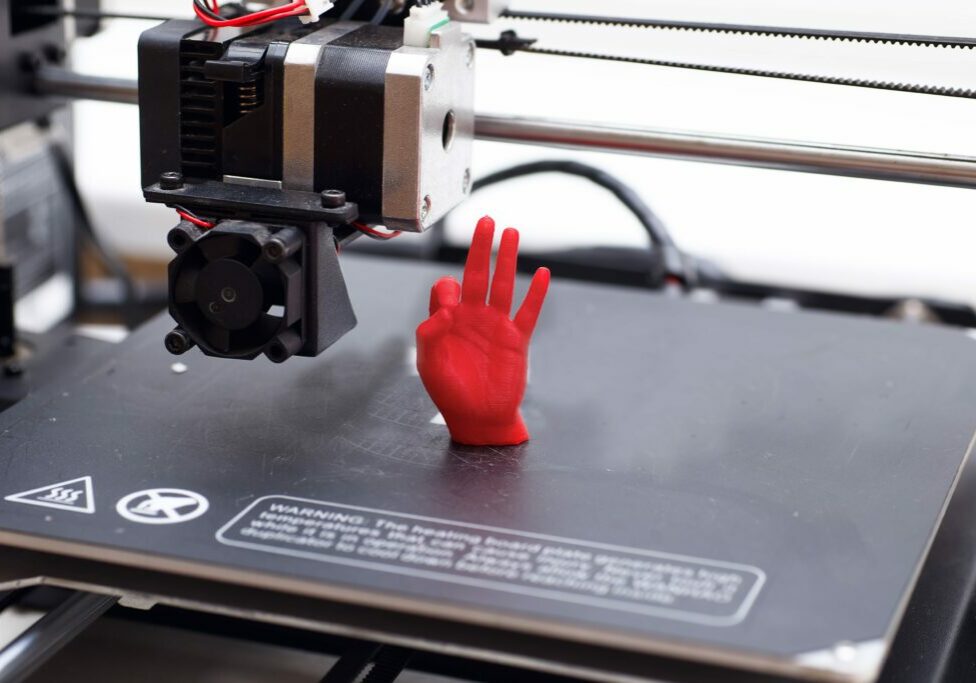Published in the December 2016 NJEA Review
By Adrienne Markowitz and Eileen Senn
As they become smaller and more affordable, 3-D printers are finding their way into classrooms, especially in art and graphic design and STEM programs. The printers create a three-dimensional object by forming successive layers of materials under computer control. The printers can be used to make unique arts and crafts objects; topographic maps; replicas of biological specimens, artifacts and fossils; models of chemical compounds, molecules, geometric shapes and graphs; and much more.
Futurologist Jeremy Rifkin has called 3-D printers the third industrial revolution. As digital manufacturing, the printers bring manufacturing out of the factory and into the classroom where adequate ventilation may not be present. 3-D printers may put staff and students at risk for exposure to hot surfaces, molten plastics, and airborne particulate and volatile organic compounds.
How 3-D printers work
There are several types of 3-D printing technologies, but most desktop printers use the fused deposition modeling technique in which a heated nozzle melts a solid thermoplastic filament, usually petroleum-based acrylonitrile butadiene styrene (ABS) plastic or corn-based polylactic acid (PLA). Following a computer-generated image, the 3-D printer forces these filaments through a heated nozzle that melts the material into thin layers which then harden to create a solid replica of the image. 3-D print jobs last from minutes to hours. The nozzles extrude at 428 to 464 degrees F.
Ultrafine particles produced
A Swiss researcher has found that ABS filament releases styrene monomer and PLA filament releases methyl methacrylate. If ABS filament is burned or overheated above 482 degrees F it can release decomposition products including carbon monoxide, nitrogen oxides, hydrogen cyanide and flammable and reactive carcinogens including acrylonitrile and styrene monomer.
Researchers at the federal National Institute for Occupational Safety and Health (NIOSH) recently found that the tested desktop 3-D printer released high numbers of ultrafine particles (UFPs) as it printed. UFPs are tiny particles less than 100 nanometers in diameter that can lodge deep in the lungs and produce inflammation, headaches and adverse cardiovascular effects. A human hair is approximately 60,000 nanometers wide.
The emissions peaked a few minutes after printing began and they did not return to baseline until about 100 minutes after printing ended. Investigators found that using the manufacturer-supplied cover on the printer decreased the number of particles, but the reduced number was still high. The researchers also found that the amount and particle size of emissions varied by filament type and color.
Particles linked to asthma
In a related ongoing study, NIOSH investigators found that compared to a laser printer, a desktop 3-D printer emitted smaller particles and far greater amounts of certain chemicals linked to asthma. The investigators also found that 3-D printers emit chemicals that combine to form new compounds, including a chemical linked to asthma. During a malfunction, the desktop 3-D printer emitted very high concentrations of particles compared to normal operation.
These findings, like those of the first study, underscore the importance of using controls to reduce emissions from desktop 3-D printers in school settings.
Steps to reduce exposures
Local associations should work with their UniServ field representatives to ensure that districts reduce exposures to 3-D printer emissions. NIOSH recommends these control measures:
- Always use the manufacturer’s supplied controls. Full enclosure can be more effective at controlling emissions than a cover.
- Use the printer in a well-ventilated place and directly ventilate the printer.
- Maintain a distance from the printer to minimize breathing in emitted particles, and choose a low-emitting printer and filament when possible. Avoid staying in the same room with a printer for long periods of time.
- Turn off the printer if the printer nozzle jams, and allow it to ventilate before removing the cover.
- Use engineering measures first, such as manufacturer-supplied equipment and proper ventilation, then use materials with lower emissions. Wear protective equipment, such as respirators, if necessary.
Local exhaust ventilation (LEV) can be an important protective measure for 3-D printers. LEV captures contaminants at or near the point where they are generated and removes them via ductwork before they can be inhaled. Such systems are usually permanently installed; portable units are also commercially available. The chemical laboratory hood is a familiar example.
The district should have a maintenance contract that provides for monthly servicing. A maintenance log should be kept for each machine and be available to staff. The user manual should also be readily available.
Chemical hazard communication
Locals should also ensure the district meets its combined requirements under the New Jersey Right to Know (RTK) Act and the Public Employees Occupational Safety and Health (PEOSH) Hazard Communication Standard to:
- Develop and implement a written hazard communication program.
- Train staff who work regularly with 3-D printers about health effects and safe handling procedures at the time of initial assignment, including all potential chemical exposures.
- Identify and list all hazardous chemicals in the school, including 3-D printer filaments.
- Develop a central file where RTK information is kept.
- Complete and submit a RTK Survey for each school every year.
- Make safety data sheets (SDS) readily available to staff during each work shift and in their work areas. The district must obtain these from their vendors.
- Make N.J. Hazardous Substance Fact Sheets (HSFS) readily available to employees. The district must obtain these from the RTK Program.
Adrienne Markowitz holds a Master of Science degree in Industrial Hygiene from Hunter College, City University of New York. Eileen Senn holds a Master of Science degree in Occupational Health from Temple University in Philadelphia. They are consultants with the New Jersey Work Environment Council, which is a frequent partner with NJEA on school health and safety concerns.
For more information
- “Insist on Protective Measures,” NJEA Health and Safety Manual
- New Jersey Hazard Communication Standard, NJAC
- New Jersey Indoor Air Quality standard, NJAC
Note: Links are case sensitive.
